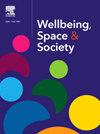Exploring the impact of demographic, architectural, and well-being factors on health outcomes in informal settlements: The role of daylight, window depth, and building orientation
IF 2.2
Q2 GEOGRAPHY
引用次数: 0
Abstract
Inhabitants of informal settlements face socio-economic difficulties and suboptimal living conditions, where demographic, architectural, and well-being factors interrelate to determine quality of life (QoL). This paper explores how these interactions occur and how architectural interventions can shape these environments in ways that contribute to improved health outcomes. We conducted a demographic and architectural study, with a focus on daylighting among selected inhabitants. We also investigated well-being by utilizing the SF-36 and Pittsburgh Sleep Quality Index (PSQI) surveys to measure health and sleep quality. The results clearly showed that older age and lower education are strongly related to poor health, while natural light exposure and better building orientation are strongly related to improvement in sleeping quality and, hence, good health. Distinct clusters emerged from this population; for instance, the employed and better-educated people presented higher well-being. Interaction effects also showed how age, education, and daylight exposure are interactively determining health and sleep outcomes. The health of the less educated elderly decreases at a much greater rate; accessibility to daylight moderates this. Such findings hint at targeted interventions that might involve optimal window placement, coupled with improvements in building orientation and social support measures to enhance general well-being among vulnerable groups. Merging these architectonic and socio-economic factors, the interventions could contribute a lot to people living a better life in such informal settlements.
探索人口、建筑和福祉因素对非正式住区健康结果的影响:日光、窗户深度和建筑朝向的作用
非正式住区的居民面临着社会经济困难和次优生活条件,其中人口、建筑和福祉因素相互关联,决定了生活质量(QoL)。本文探讨了这些相互作用是如何发生的,以及建筑干预如何以有助于改善健康结果的方式塑造这些环境。我们进行了人口统计和建筑研究,重点关注选定居民的采光。我们还通过SF-36和匹兹堡睡眠质量指数(PSQI)调查来衡量健康和睡眠质量。结果清楚地表明,年龄较大和受教育程度较低与健康状况不佳密切相关,而自然光照射和更好的建筑朝向与睡眠质量的改善密切相关,从而与健康状况密切相关。从这个种群中出现明显的集群;例如,有工作和受过良好教育的人表现出更高的幸福感。相互作用还表明,年龄、教育程度和日光照射如何相互作用地决定健康和睡眠结果。受教育程度较低的老年人的健康状况下降的速度要大得多;日光的可及性缓和了这一点。这些发现暗示,有针对性的干预措施可能包括优化窗户位置,以及改善建筑朝向和社会支持措施,以提高弱势群体的总体福祉。结合这些建筑和社会经济因素,这些干预措施可以为人们在这种非正式住区中过上更好的生活做出很大贡献。
本文章由计算机程序翻译,如有差异,请以英文原文为准。
求助全文
约1分钟内获得全文
求助全文
来源期刊

Wellbeing Space and Society
Social Sciences-Social Sciences (miscellaneous)
CiteScore
2.70
自引率
0.00%
发文量
46
审稿时长
124 days
 求助内容:
求助内容: 应助结果提醒方式:
应助结果提醒方式:


